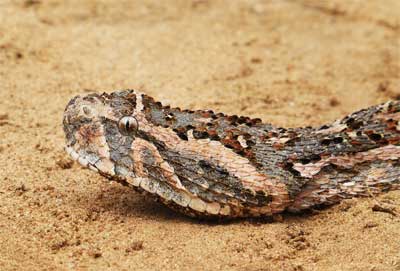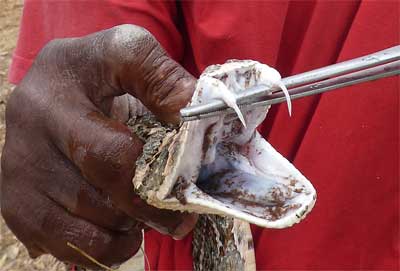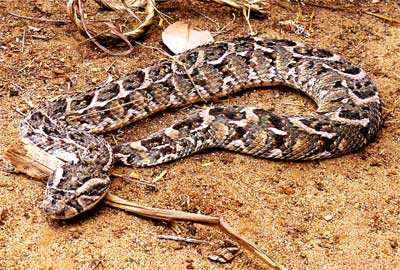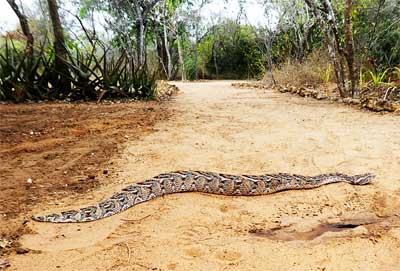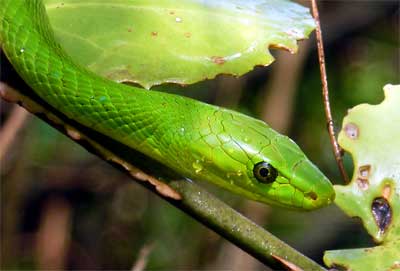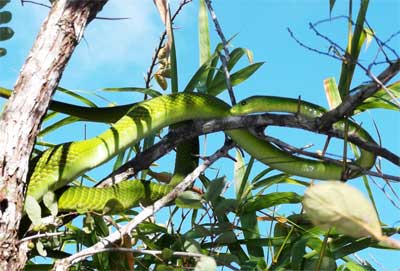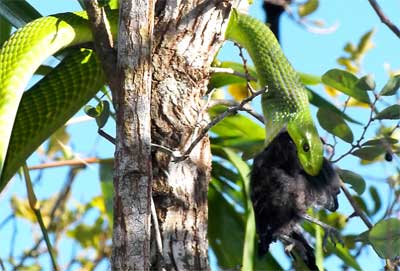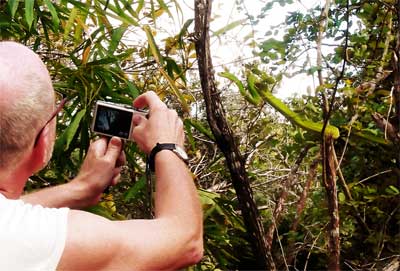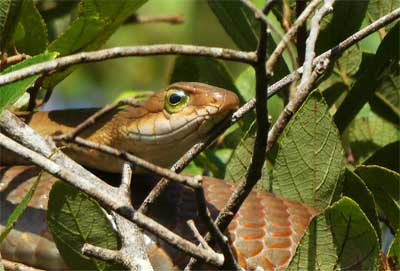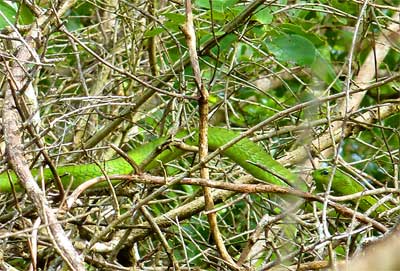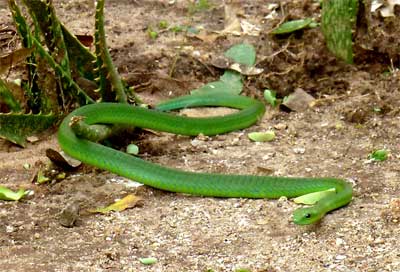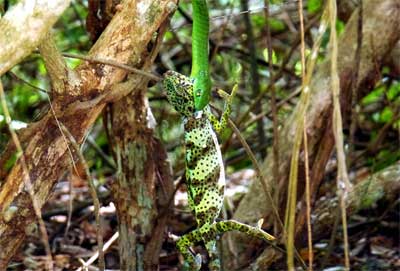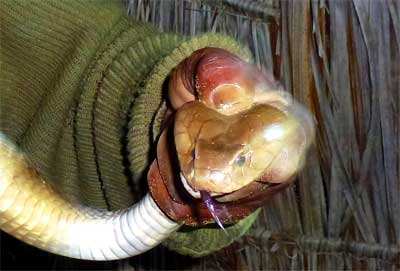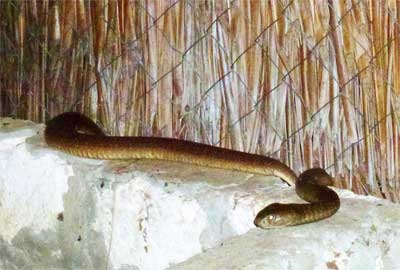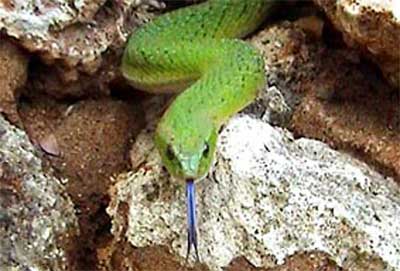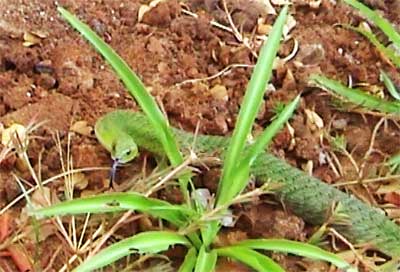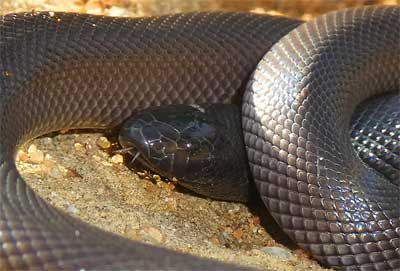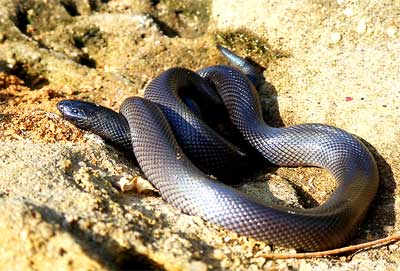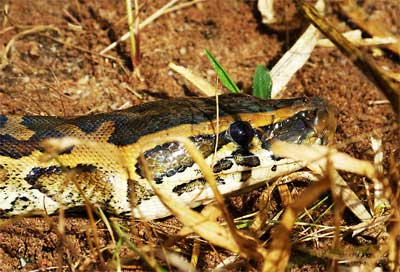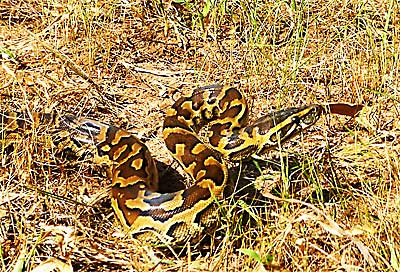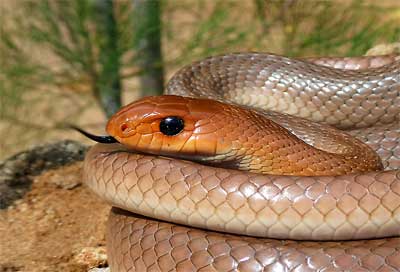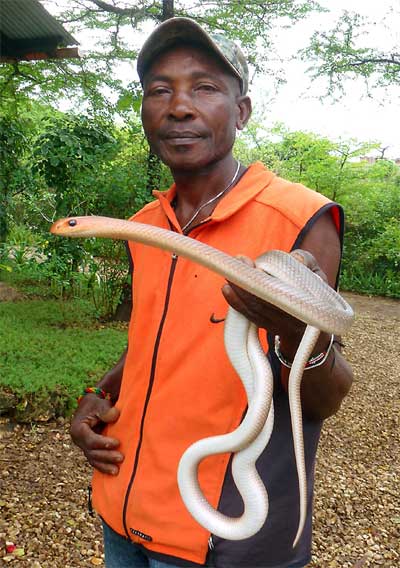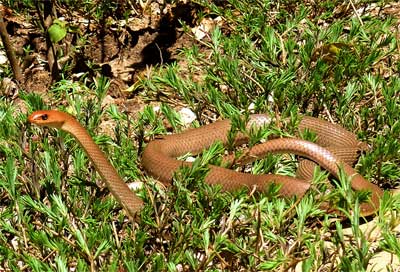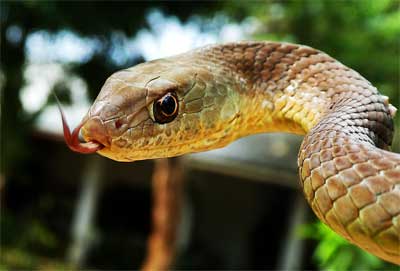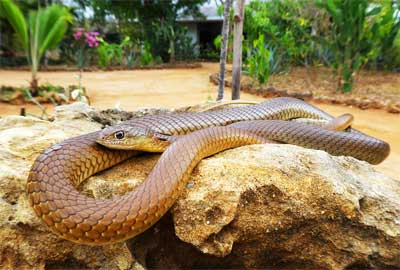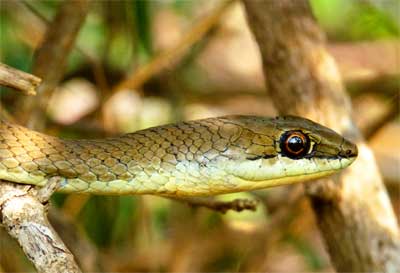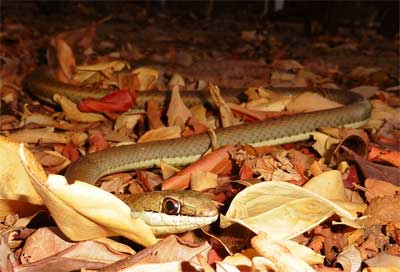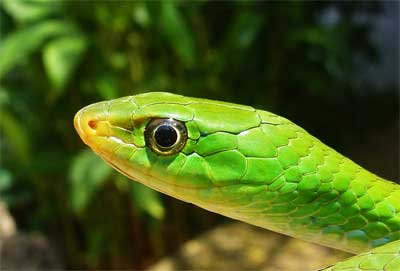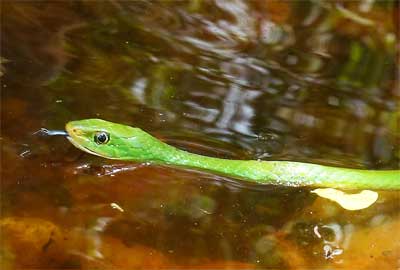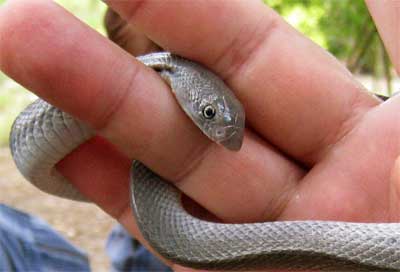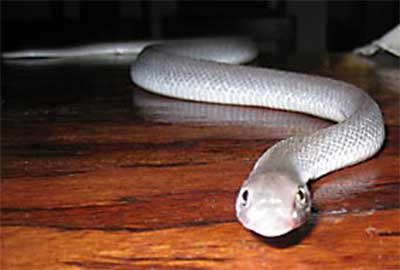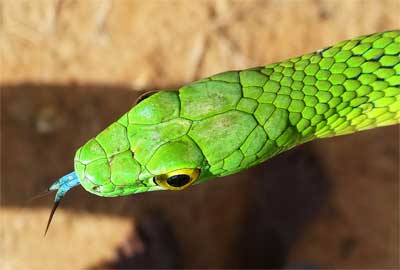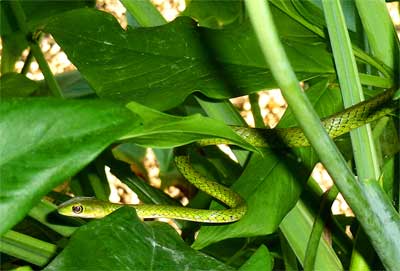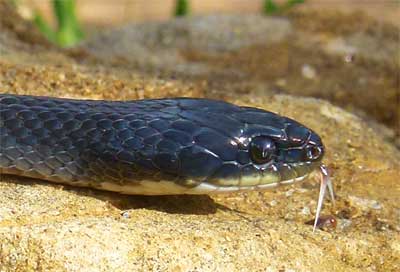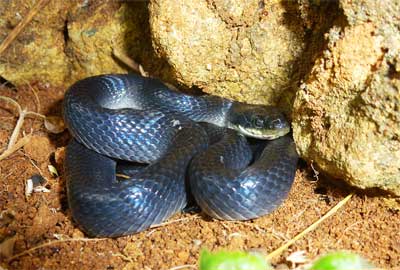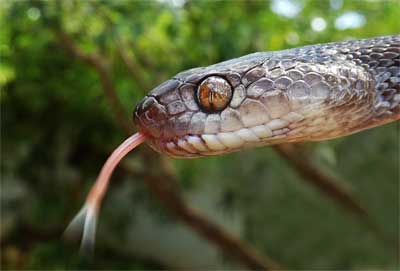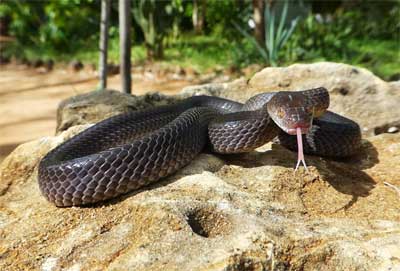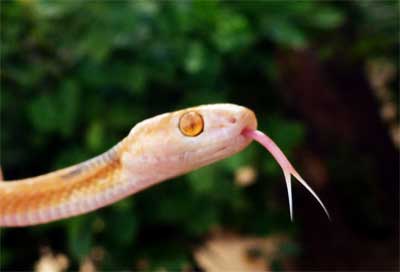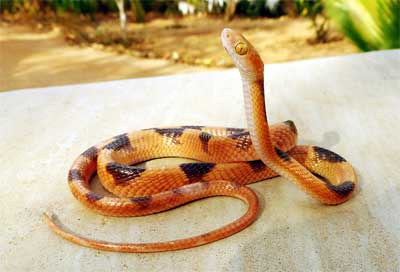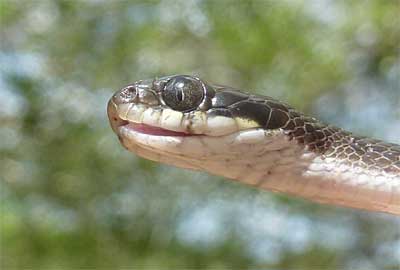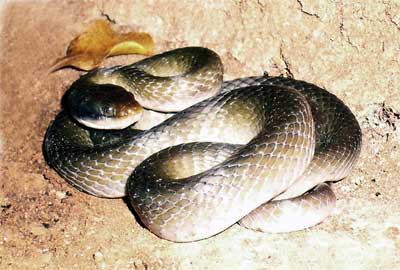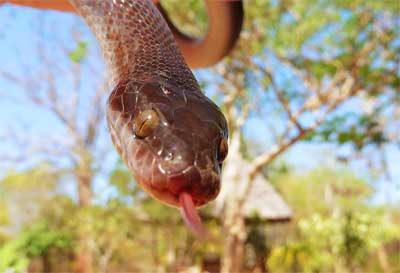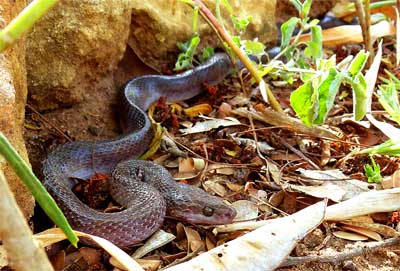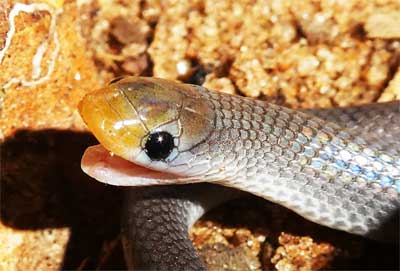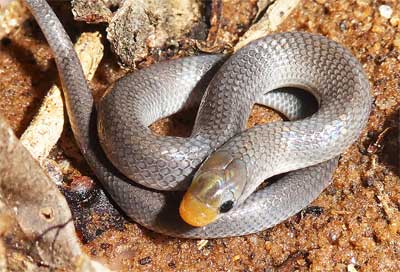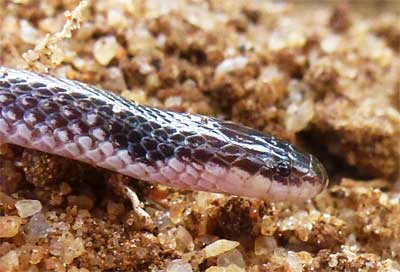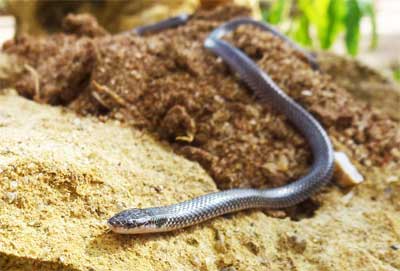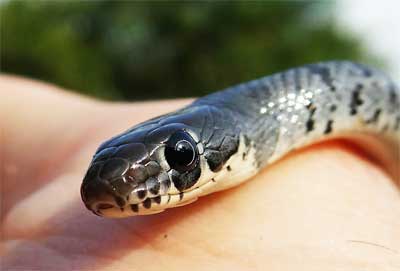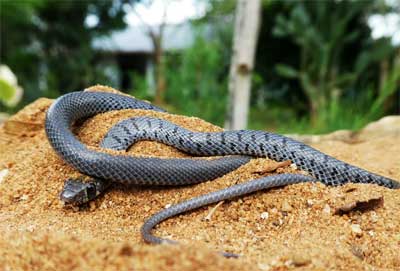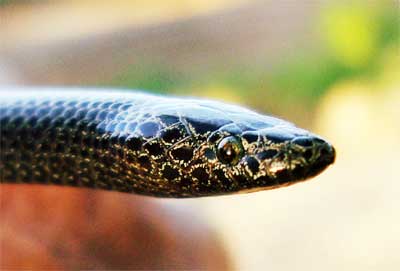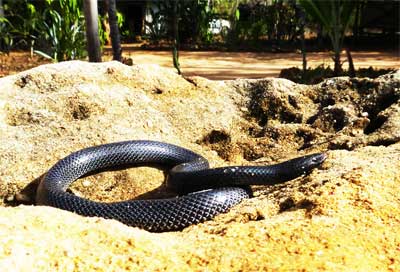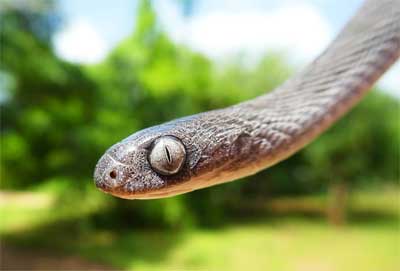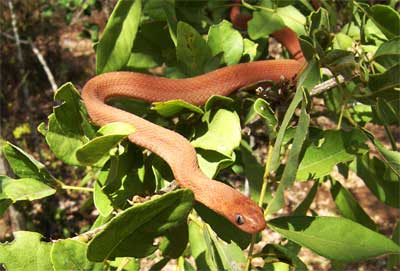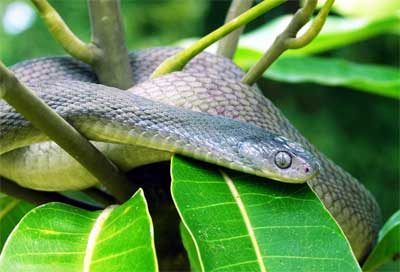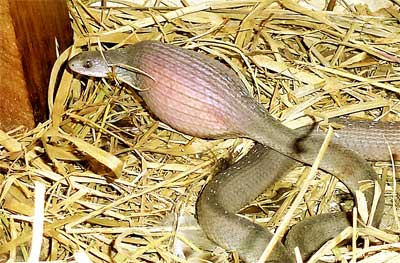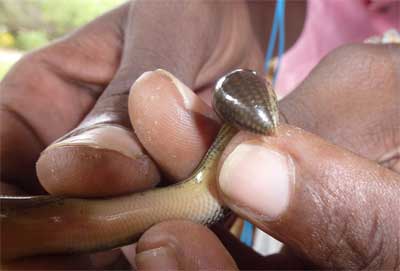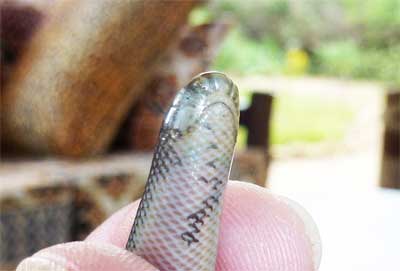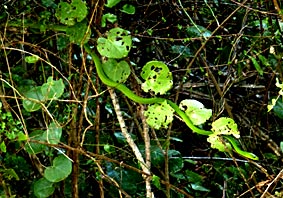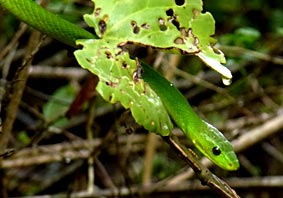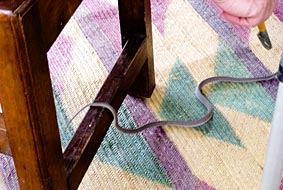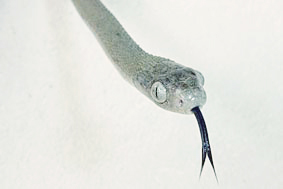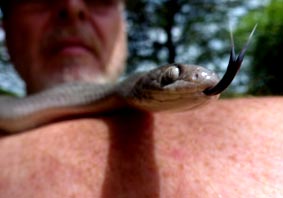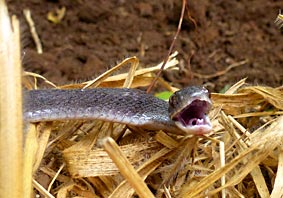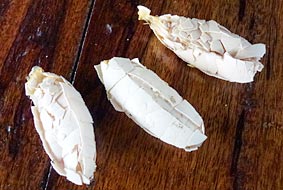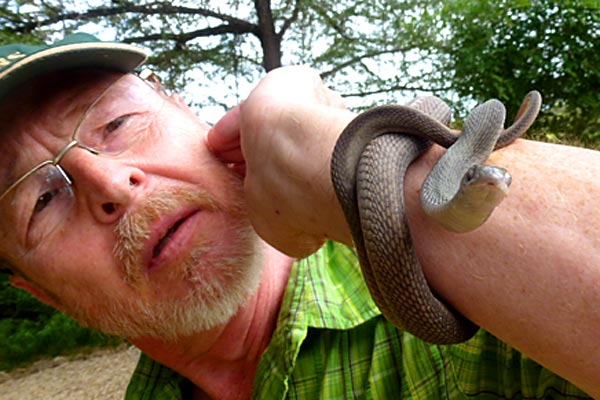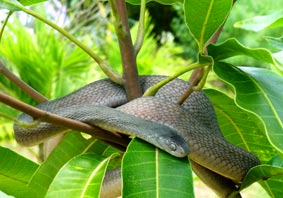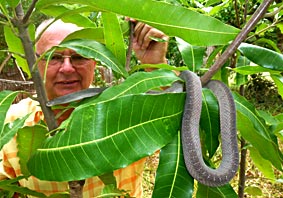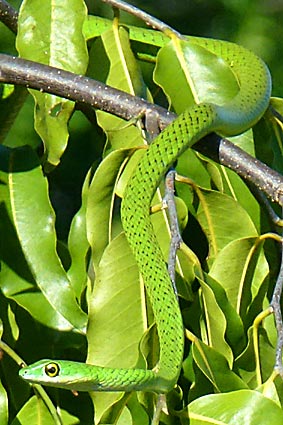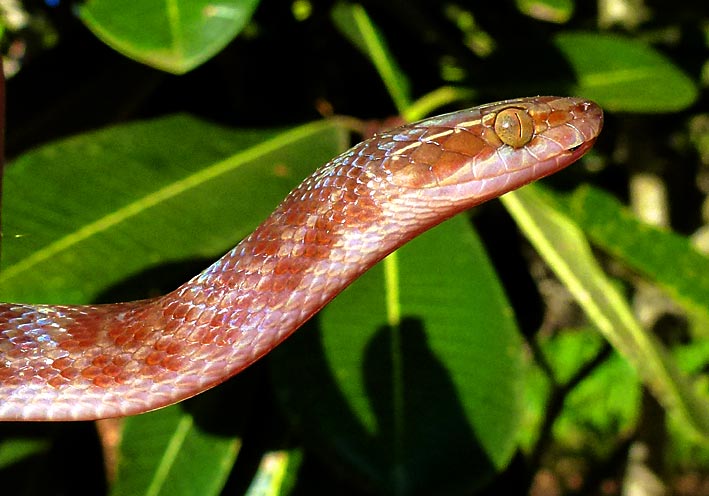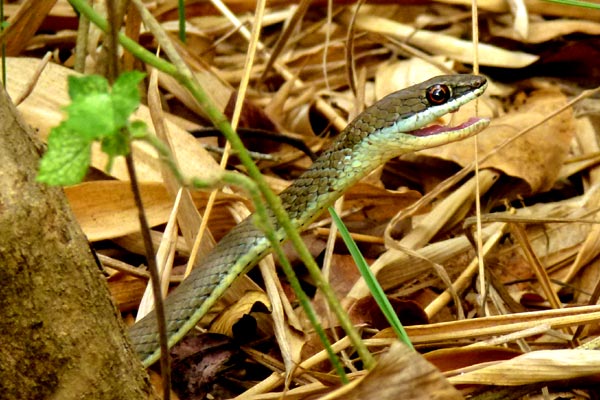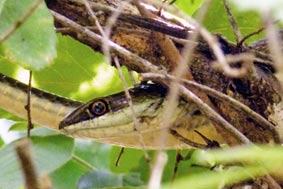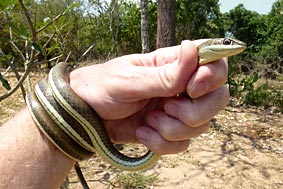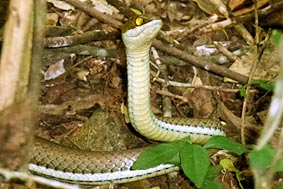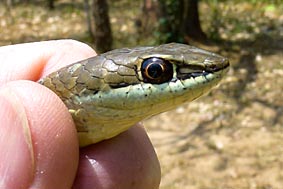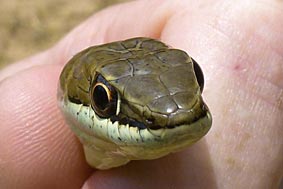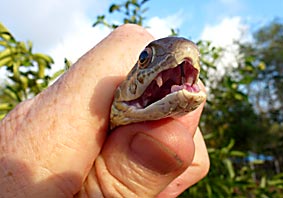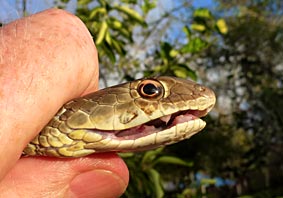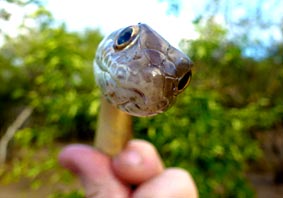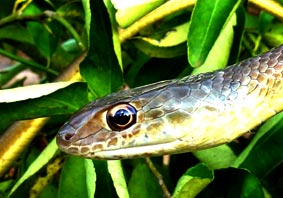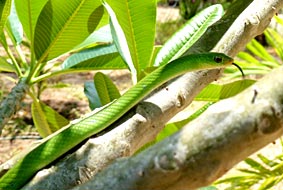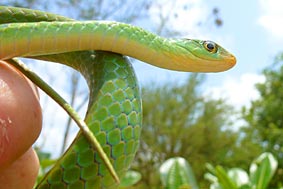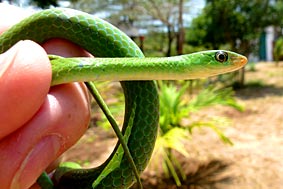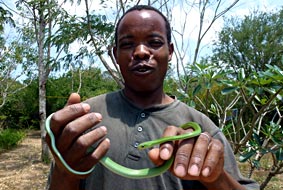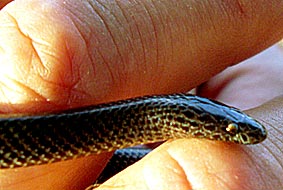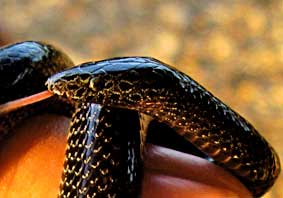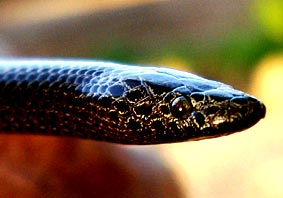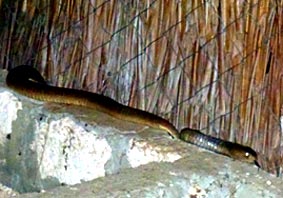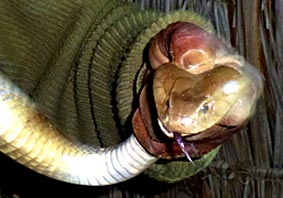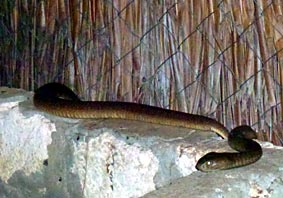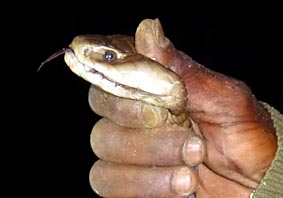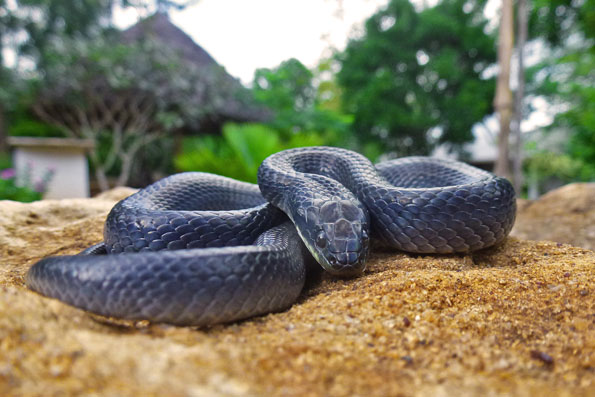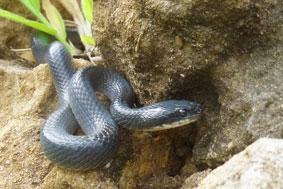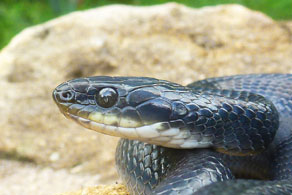|
Snakes
By the way, all the animals that can be seen here, are free-living on the farm land, and are not kept in cages.
|
|||||||||||||||||||||||||||||||||||||||||||||||||||||||||||||||||||||||||||||||||||||||||||||||||||||||||||||||
| Here are 24 species of snakes that I have seen on the farm so far.
More photos
and information |
|||||||||||||||||||||||||||||||||||||||||||||||||||||||||||||||||||||||||||||||||||||||||||||||||||||||||||||||
|
||||||
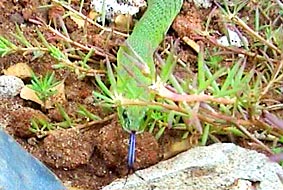 |
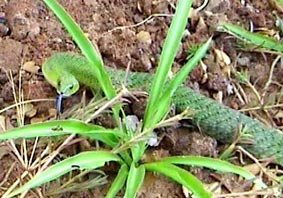 |
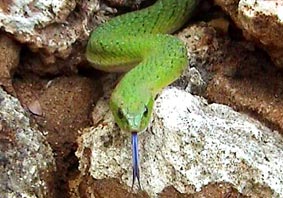 |
||||
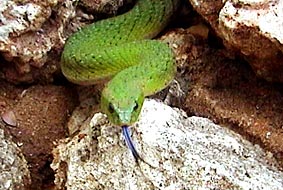 |
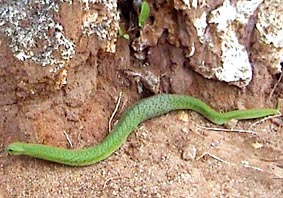 |
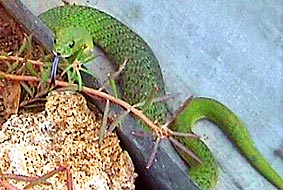 |
||||
| If green night adders be disturbed, they swell up and introduce them self with a wild hiss. They hunt mostly on the ground, are good swimmers and can climb well behind their prey. The name is misleading; because it really is a day active reptile and it like to take sun baths. For sleeping it hides in the thicket floor. The
green night adder is classified as very aggressive because she bites
to defend wildly. After about 20 minutes the snake had made it and now was looking for a quiet place to digest in one of the many holes on the rough stone wall.
|
||||||
| The
Boomslang is naturally very shy and we barely get to see. Normally
it lives on trees and shrubs, but also on the ground it is a good hunter. A green copies with brownish head top and blue dots I saw swallow a bird in the undergrowth. |
||||||
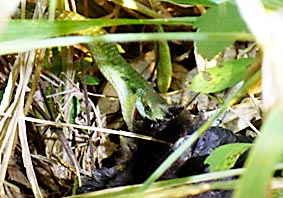 |
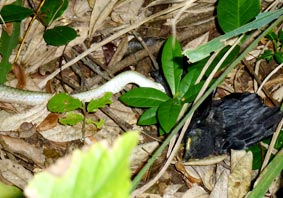 |
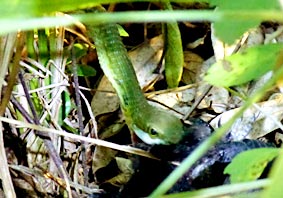 |
||||
| These young Boomslang I found in the afternoon between the gardening tools. But before she could flee, I quickly was about to capture this 50 centimeters long reptile. The
fangs of a Boomslang are very deep far in the jaw. | ||||||
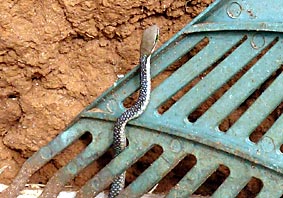 |
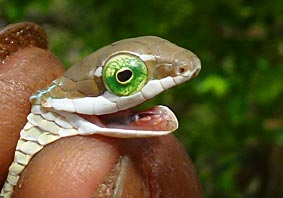 |
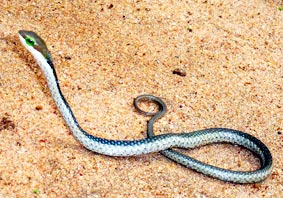 |
||||
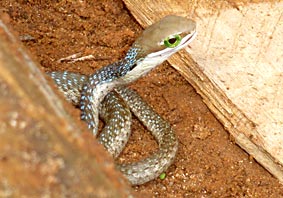 |
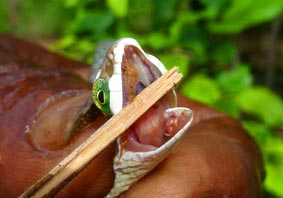 |
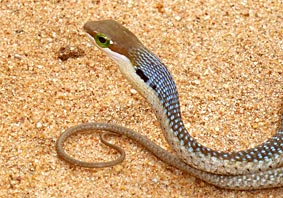 |
||||
| The
Boomslang pictured below was about one meter long and very nimble. |
||||||
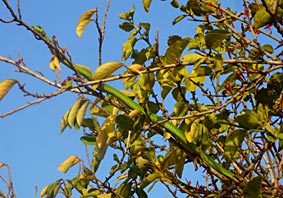 |
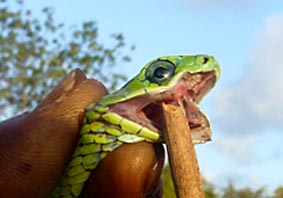 |
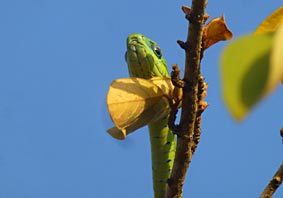 |
||||
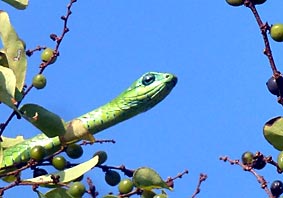 |
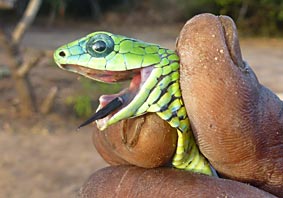 |
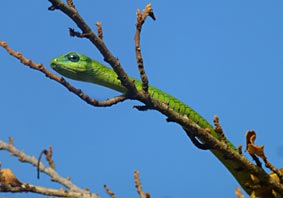 |
||||
The diurnal Boomslang chases like in bushes and trees. If she has spotted prey, solidified her front body and then pushes lightning fast. Their main diet consists of chameleons and birds, but also other lizards and small vertebrates are not scorned. In spring time 2015 I witnessed as a boomslang kill a chameleon, and then eaten. |
||||||
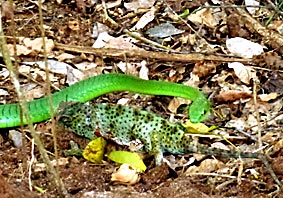
|
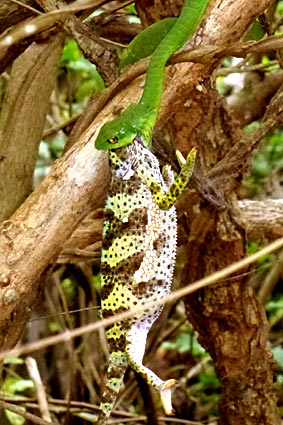 |
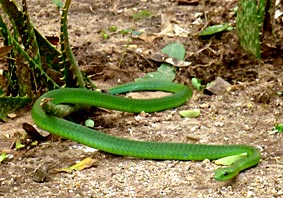 |
||||
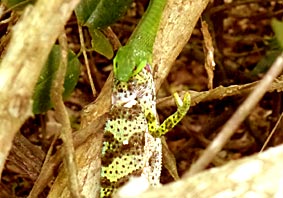 |
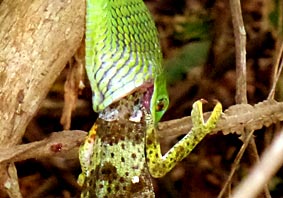 |
|||||
| The
nearly 2-meter-long Boomslang bites its victim on the left side in the
neck. Since chameleons are very slow by nature, he succeeds not really. Now more than ever not after it has received the lethal dose of venom, but it can move a few meters. The snake is now looking and smelling with his tongue their sacrifice. She has finally found it. It is alive and still moving. Now she waits until the chameleon is no longer alive. Now it begins to devour their prey. She
moves more and more into the thicket. |
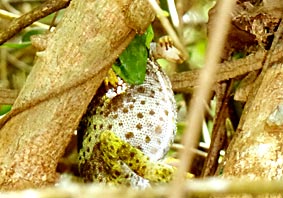 |
|||||
|
||||||
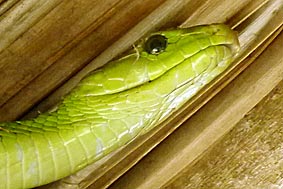 |
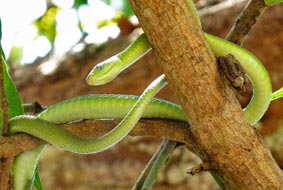 |
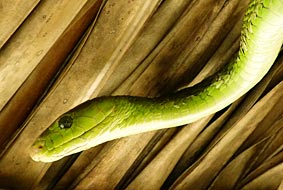 |
||||
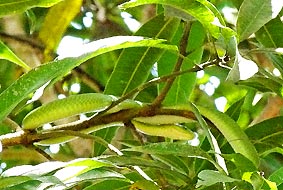 |
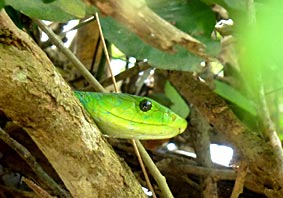 |
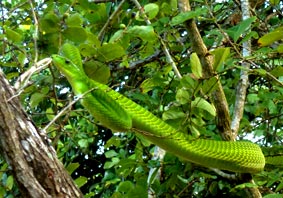 |
||||
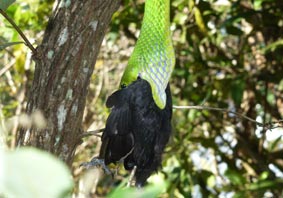 |
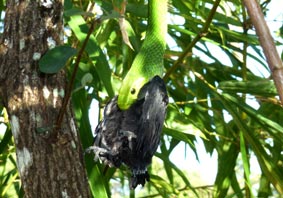 |
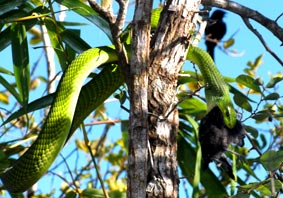 |
||||
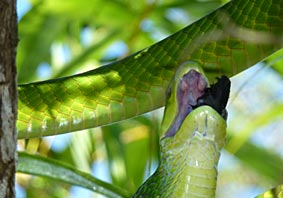 |
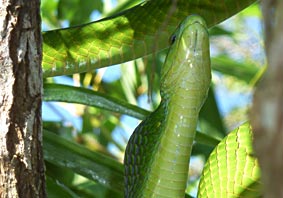 |
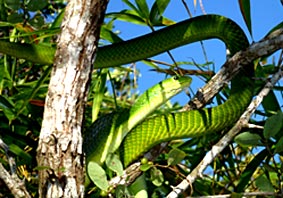 |
||||
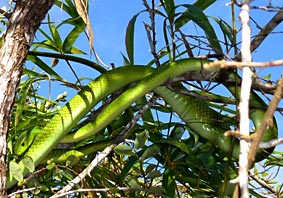 |
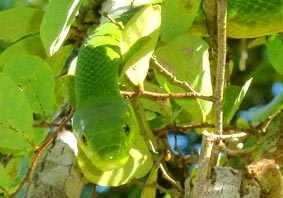 |
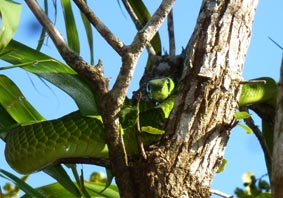 |
||||
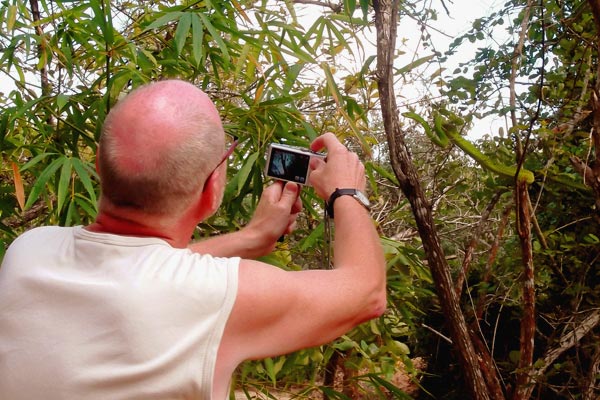 |
The Green Mamba is observed almost always on a walk through our bush. It is a typical tree inhabitant and feeds mainly on birds and eggs, but also other tree-dwellers are on the menu. They are spatial fidelity and can be up 250 centimeters lenght. This shy and non-aggressive snakes prefer rather to flee from danger, unless their return path is cut off. |
|||||
| In October 2014 during the breeding season, in our garden were two Fork-tailed Drongo babies, which were not yet fledged from the nest. The parents were able to direct their children to a nearby small tree and they resupplied with food. Suddenly, an about 2 meters long green mamba came quickly snaked up the tree and caught one of the little ones. The other escaped. But was unfortunately later eaten by a Boomslang as well. The parent birds attacked again and again the long snake with swoopings in to save her cub, but in vain. After about 20 minutes the Mamba had swallowed the little bird and wanted to retire to digest. That she did not succeed because the Drongo couple attacked the green mamba again and again. It took more than an hour until the green reptile escaped to the nearby thicket. -------------------------------------------------------------------
|
||||||
|
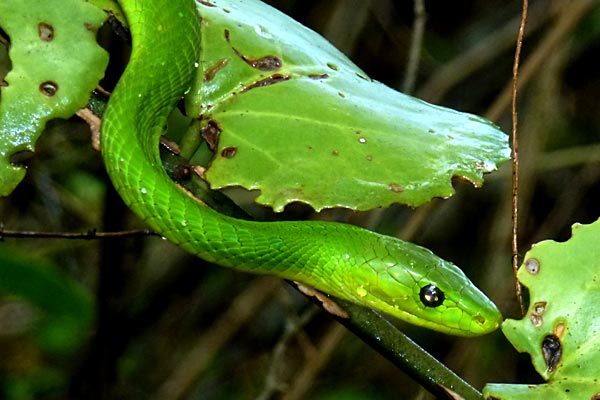 |
|||||
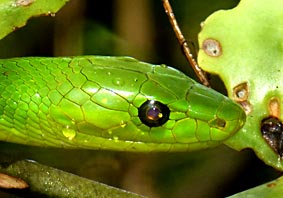 |
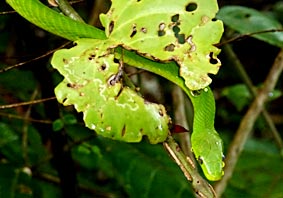 |
Here is a well-camouflaged over 2 meter long green mamba in the rain, directly above one of the bird bath. This snake visited
us about every 2 weeks, always in the afternoon from 4 o’clock
and always in the same bush. |
||||
|
||||||
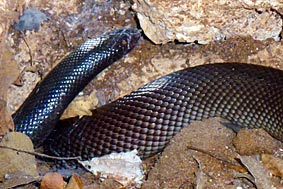 |
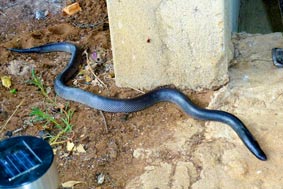 |
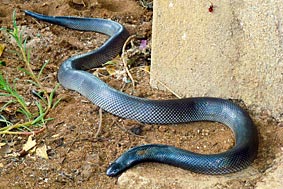 |
||||
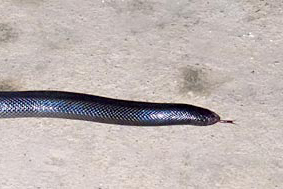 |
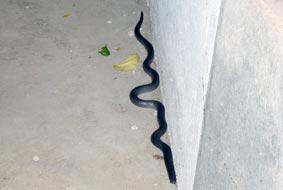 |
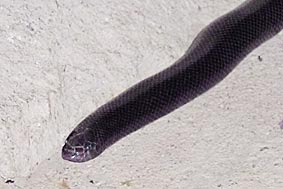 |
||||
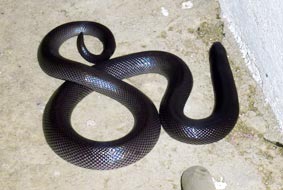 |
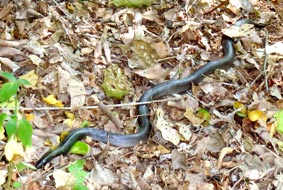 |
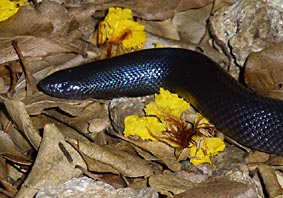 |
||||
| One of the most feared snakes in our region. As the name suggests, these animals live underground. That is why you see them so rarely. Bites happen mostly at night. During heavy rains, they come to the surface and look for a dry place. They even come up in the huts and houses, which then naturally during sleep on the floor but also can have consequences when walking barefoot. Like most snakes, they also warn of an attack, in which they bite aggressively several times. This Burrowing Asps visited us a few times. Every time we have returned them far to the garden, where they could disappear into the undergrowth.
|
||||||
|
||||||
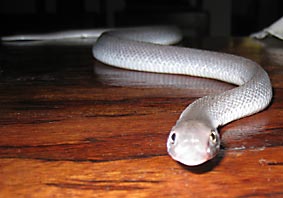 |
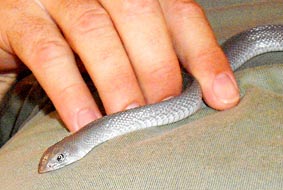 |
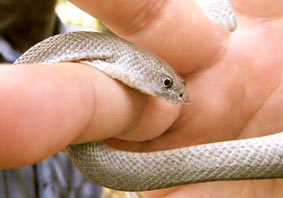 |
||||
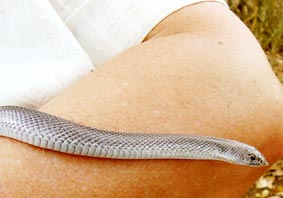 |
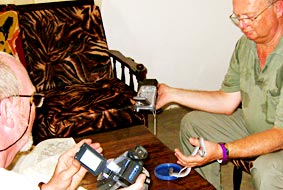 |
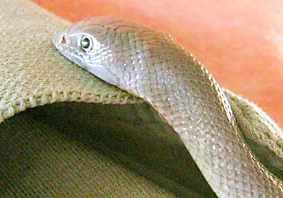 |
||||
Diese These diurnal snake was found on a tour of the nearby bush. She is not aggressive. If this snake feels threatened, it lowers the mandible, indicating its black mouth, while it raises the front body and if that not useful for she makes another false attack, in which almost the entire body leaves the ground. If she bites it does not really, it's pure bluff. Because it was very hot outside, we provided water and she drank plenty of it, as you can see here. A very peaceful snake. |
||||||
|
||||||
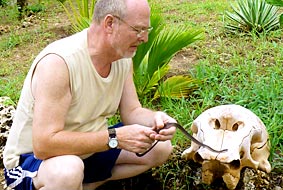 |
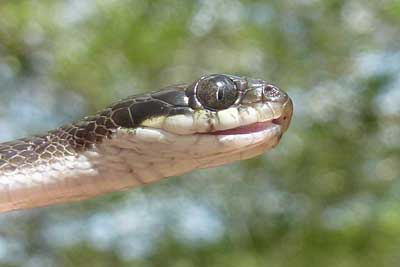 |
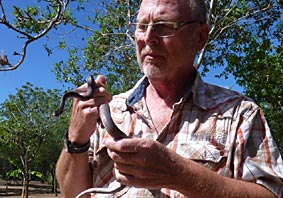 |
||||
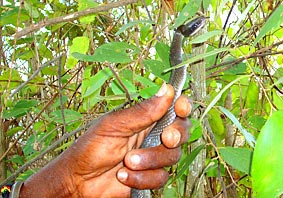 |
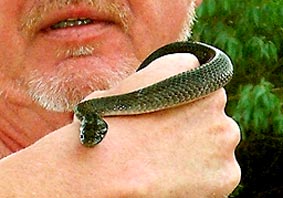 |
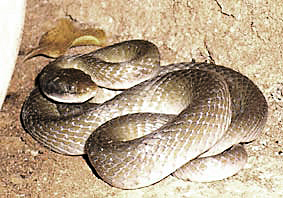 |
||||
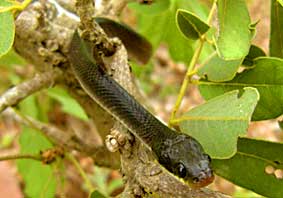 |
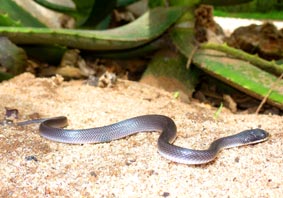 |
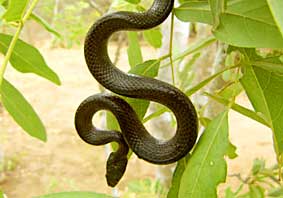 |
||||
One of these snake we found the night at the little low wall on the veranda. She was about three feet long, and because it is one of the nocturnal snakes, it was certainly oin the hunt. Their prey usually consists on frogs. When we approached her she immediately went on the defensive. When attacking you can hear a loud hiss. Many of these attacks go wrong, but when it hits, it bites brutally. Another time we found a copy in Askarihaus. She had a big belly and probably just eaten something and wanted to digest at a quiet place. On the hand, the white-lipped snake is very active, but not dangerous. During the day it hides in hollows. |
||||||
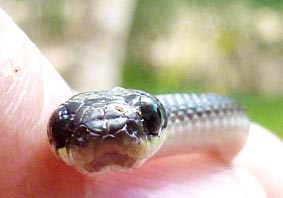 |
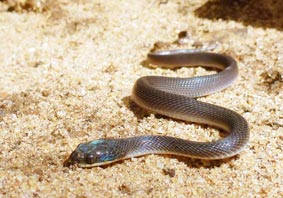 |
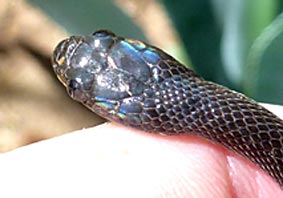 |
||||
Here
we can see a juvenile of about 50 centimeters long.
|
||||||
| |
||||||
|
||||||
|
|
|
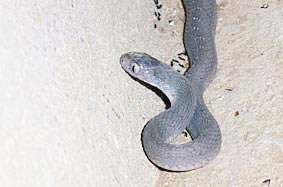 |
||||
One morning at breakfast Guenther noticed a snake crawls up on his chair. We have captured the little reptile once and finished our breakfast in peace.
|
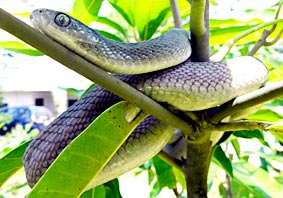 |
|||||
|
|
|
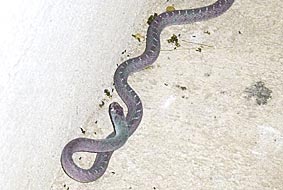 |
||||
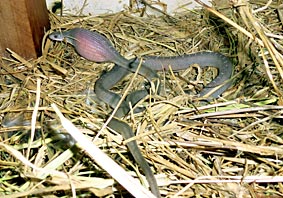 |
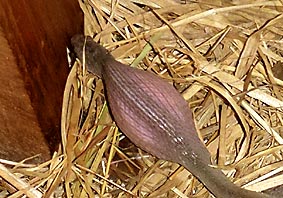 |
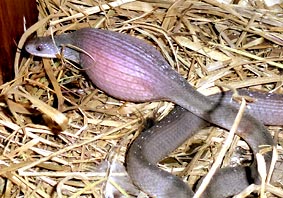 |
||||
Their color from brown to gray occurs through to dark olive and also with other patterns. But we can recognise by the short head and the eye with the vertical pupil. This snakes are crepuscular and nocturnal and like to hide during the day in Termite nests. They can grow up to 110 centimeters lenght.
|
||||||
|
|
|
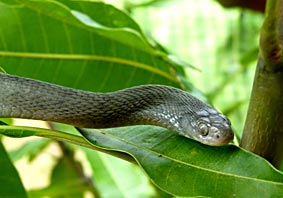 |
||||
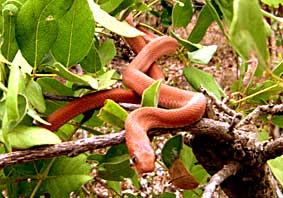 |
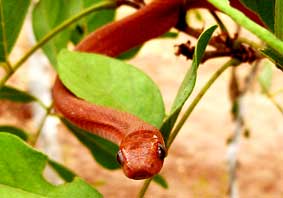 |
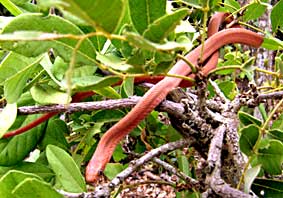 |
||||
| Species
of this snake are showing different colors from mixtures of browns and
greens, to grey and black. Also this brown copy we found in the garden.
|
||||||
|
||||||
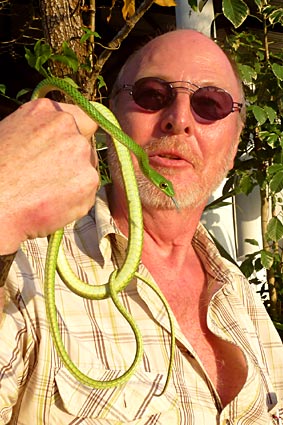 |
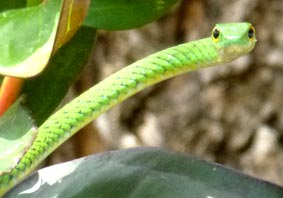 |
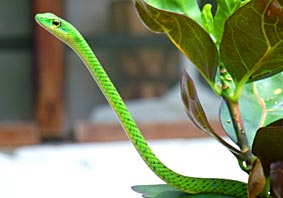 |
||||
|
|
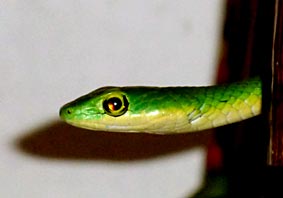 |
|||||
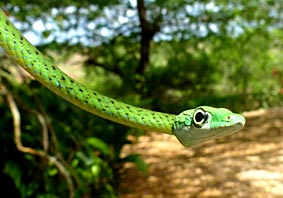 |
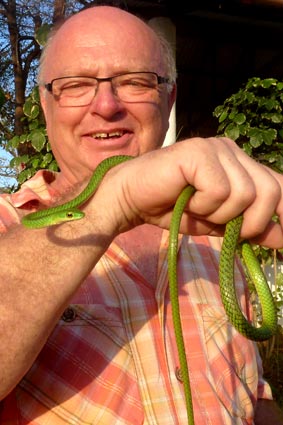 |
|||||
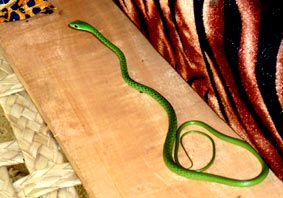 |
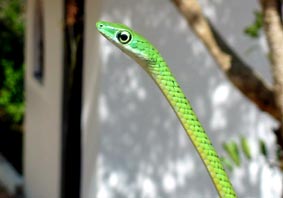 |
|||||
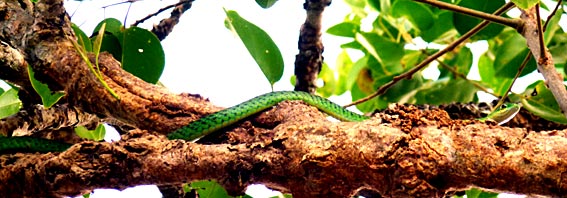 |
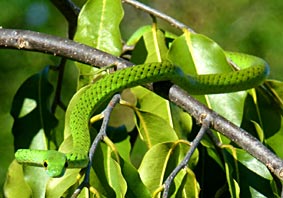 |
|||||
| This nimble snake has here already pretty caused excitement. One morning while making beds we found her inside a mosquito net. Also she likes to sleep under the sofa cushions in the pavilion, which is why every morning we have to check the sofas for snakes. Green bush snakes can reach up to 100 centimeters in length and are often confused with its toxic cousin and therefore gladly killed. Their staple diet are geckos and frogs, which they hunt during the day. As the name suggests, they live mostly in trees and bushes. You can even climb up rough house walls. We get regular visits from them, even in the areas where they then go on Gecko hunting. Otherwise it is a very peaceful snake. |
||||||
| ||||||
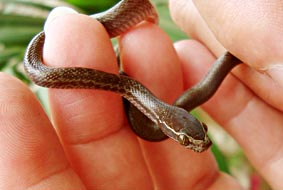 |
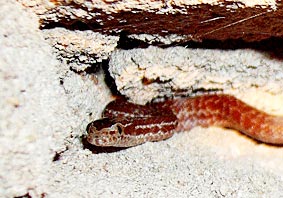 |
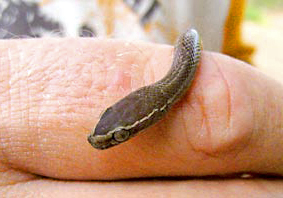 |
||||
|
|
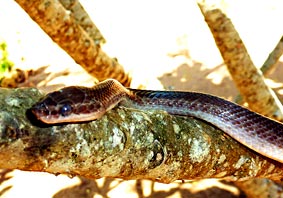 |
|||||
| (Top row). Although only a small specimen. But a nice snake. Brown house snakes can grow to one meter lenght and are colored from dark brown to light brown, often spotted in the front third. A special feature are the bright stripes left and right on the head. They are crepuscular and nocturnal and usually they don't bite |
||||||
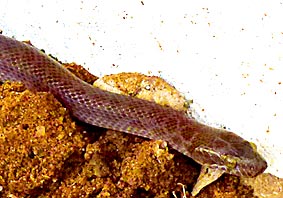 |
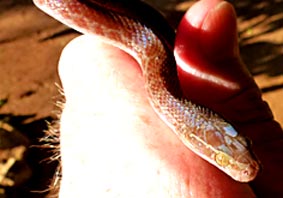 |
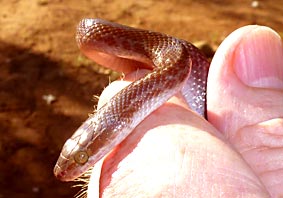 |
||||
|
They
are encountered very often in settlements, house snakes diet consists
of mice, rats and birds. |
||||||
| |
||||||
|
||||||
|
|
|
|||||
|
|
|
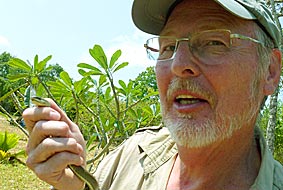 |
||||
|
|
|
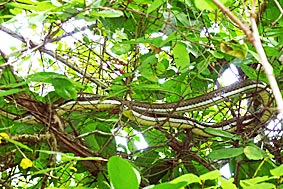 |
||||
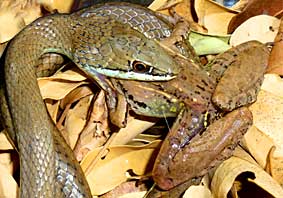 |
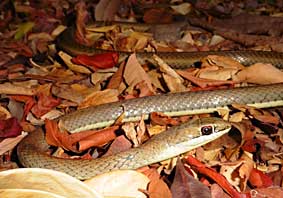 |
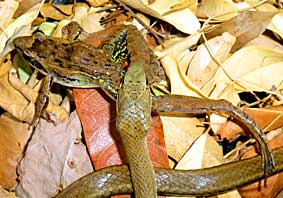 |
||||
| Sand snakes are diurnal. With its head raised moving at breakneck speed to move through the landscape. With the black mamba they rank among the fastest snakes in Africa. Tthey climb on shrubs and small trees and hunt down anything that moves. At night they hide in caves or trees, but sometimes even sleep in the bushes on branches. This medium-sized snakes can grow up to 120 centimeters and are considered unpredictable. Their venom can cause swelling, nausea and itching, so you should definitely be careful when handling them. They
have a wide range of prey and swallow their victims when they are killed
by the poisonous bite. |
||||||
|
||||||
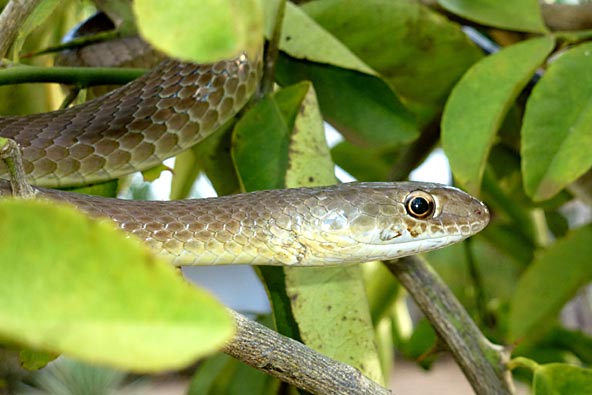 |
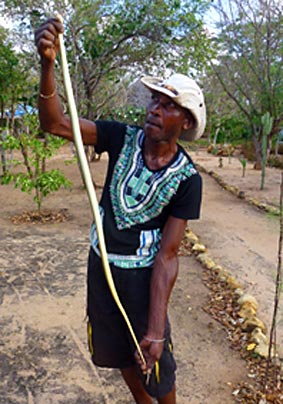 |
|||||
|
|
|
 |
||||
|
|
|
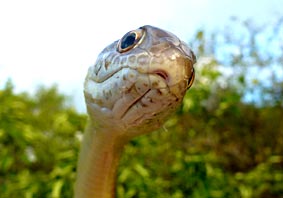 |
||||
Like all sand snakes are also the olive-brown sand snakes diurnal. With raised head they can move at a furious pace through the countryside. They include not only the black mamba among the fastest snakes in Africa. They are found more frequently on the water or in wet meadows, but also in the savannah and in the forest habitats. If one tries to approach her, it disappears very quickly. They not only live on the ground, but also climb on shrubs and small trees and chasing anything that moves. At night they hide in caves or trees, sometimes they sleep in dense bushes on outer branches. They have a wide range of prey, including rodents, lizards and frogs, but also puff adders and black mambas. They devour their victims after they have slain them by the venomous bite. These snakes can grow up to 180 cm long and generally seen as unpredictable but not dangerous to humans. The poison is only mild, but can cause local pain, swelling, nausea and itching. |
||||||
|
||||||
|
|
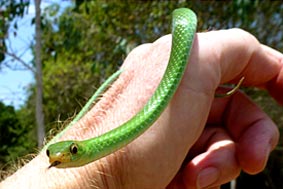 |
||||
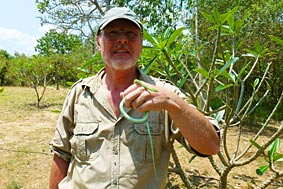 |
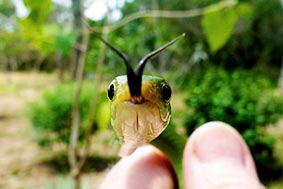 |
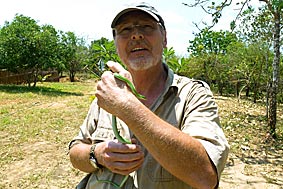 |
||||
|
|
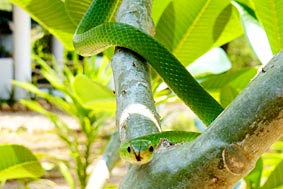 |
||||
| The green water snake with its short head and yellow-orange mouth is by nature a very quiet and docile snake. They can grow up to one meter. As a very good swimmer, she is on the ground and also on bushes very well at home, where she also sleeps at night. Their food is mainly of frogs and lizards. When they hunt in the water, she also catches fish. More than half an hour, we have used them as a model. We released her several times to the garden and taken again to the hand. It gave me a lot of pleasure to make these images. A very peaceful snake. |
||||||
|
||||||
|
|
|
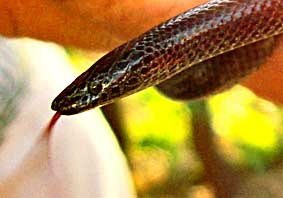 |
||||
|
|
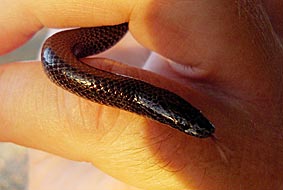 |
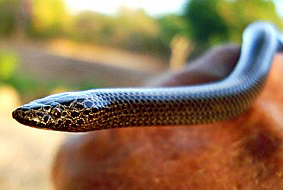 |
||||
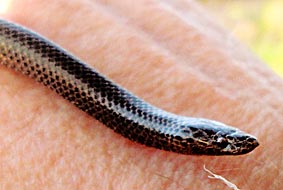
|
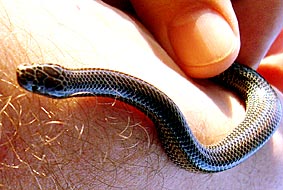 |
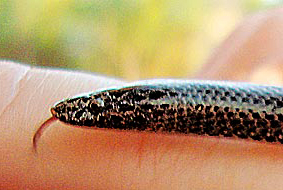 |
||||
| About this beautiful little snake, unfortunately, little is known. Since the different types of soil-dwelling snakes are very similar, so it was also very difficult to make an accurate determination. Like all underground snakes, wolf snake usually lives in deserted termite grounds, under rocks or in thatched grass or other underground openings. They love to eat lizards, especially skinks. At night they hunt down prey. This small specimen was indeed very busy but quite peaceful and has not bitten.When she feels threatened, she can make her body flat and rarely bites. |
||||||
|
||||||
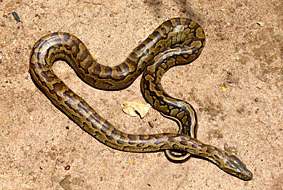 |
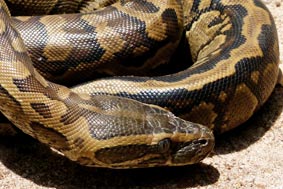 |
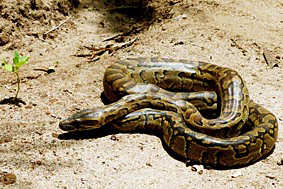 |
||||
You can not see him, but he's there. Here we see an almost 2 m long species. Some months ago a 3 meter long python has eaten all the chickens once in the chicken house at my neighbor Silvi. Young pythons encountered sometimes even on trees. They eat birds, mice, lizards, etc. Large pythons prey then even smaller to larger mammals. However, it is also reported attacks on humans. These stories are often exaggerated. When a man comes near, usually the Python takes refuge, unless he is harassed or attacked. These non-poisonous constrictors are on average 6 meters long. It should also have been given copies of up to 10 meters. He normally is a night hunter, but also during the day you can see him. Rolled up, his head on top up and waiting just if randomly a prey animal appears. Then beats his sharp teeth into the prey and suffocates it, in which he wraps around it several times. Pythons can also swim and dive and even 15 minutes remain under water. |
||||||
In autumn 2009, this more than 3 Meters long python has repeatedly entered the chicken coop of my neighbor Silvi. He must have found an entrance through the roof and thus reached into it. This snapshot shows him lazily digesting lying on the barn floor after he had swallowed the last chicken. |
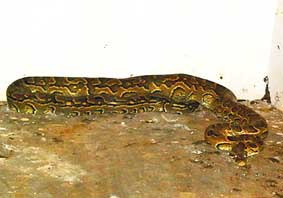 |
|||||
| In December 2013 it was a very hot and windless night. In the evening around 23:00 my night security brought me out of bed. He told all excited about a large snake in our chicken coop. A chicken was already dead and he fears that the others will die too. I quickly slapped a blanket around my waist. I grabbed the lamp and camera and we went tohenhouse about 40 meters far away. The sweat ran down my every pore. On the rear walls I saw actually a more than two-meter-long python. infront of him a dead chicken that he probably just wanted to eat. From bother us, he did well from it and then crawled straight towards the surviving chickens that were frozen there. With my strong noose wand that I already used to catch large monitor lizards, I went in and positioned the rope gently behind the large triangular head of the snake. Then I pulled the noose tight. Nailed It. | ||||||
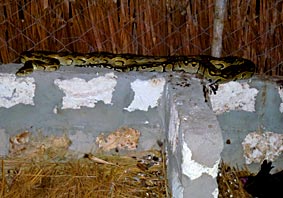 |
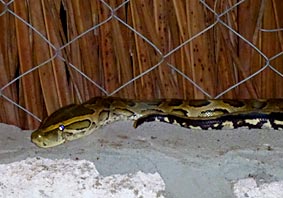 |
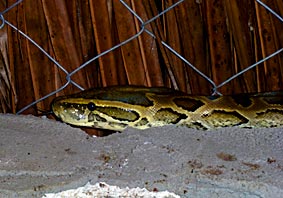 |
||||
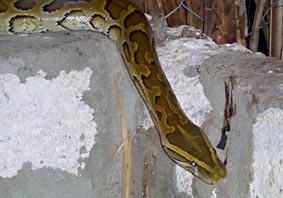 |
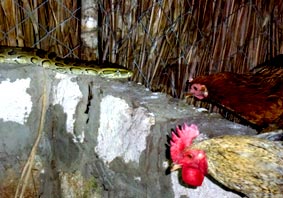 |
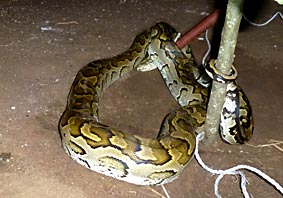 |
||||
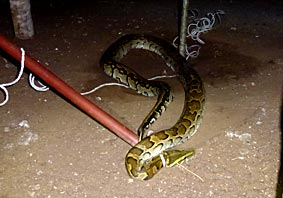 |
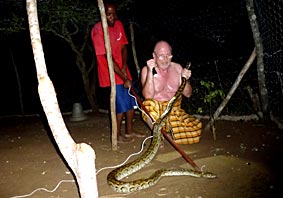 |
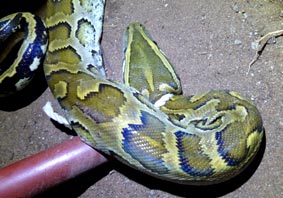 |
||||
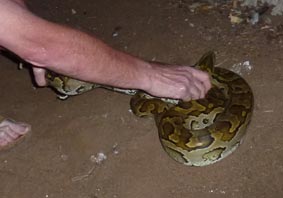 |
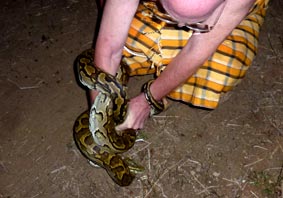 |
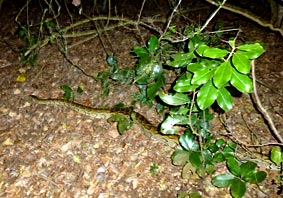 |
||||
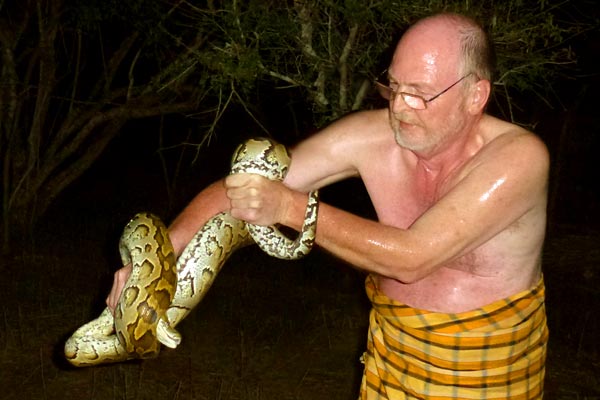 |
The Python fought desperately and beat wildly. So I drew him out of the chicken coop. Later, when he had calmed down, I caught him with my hand behind his head. He wrapped his body several times around my arm. After this embrace was solved, I brought him back into the bush, where he slowly slipped away. Actually, I expected that he comes back in the next few days. But since this incident, we have not seen a python in the henhouse again. |
|||||
| |
||||||
|
||||||
|
|
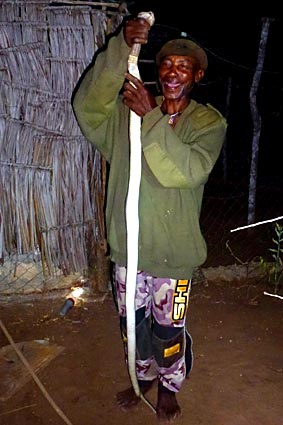 |
|
||||
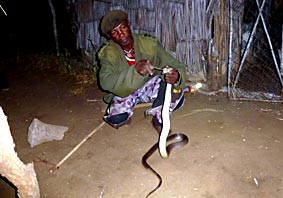 |
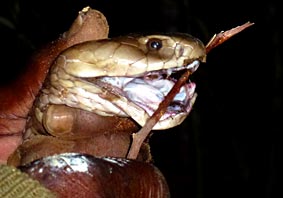 |
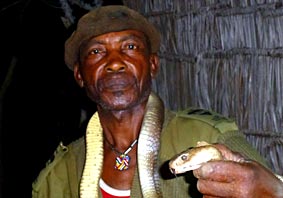 |
||||
| Almost silently, the nights are here with us in the bush. Therefore, sound risk also mean any unfamiliar. Tonight was again turmoil in the henhouse. The sleeping egg-layers had a visit from a crepuscular and nocturnal predator. And even they lost a family member. The spitting cobra has penetrated into our chicken coop and has killed a hen. This spitting cobra can be more than 2 meters long. I quickly cross my camera and rush to the henhouse. The cobra is still in there, from a safe distance I take a few photos. The chickens are now outside. The large snake tried to escape. Sammy, our snake expert grasps quickly the olive-brown reptile and keeping her safe in his strong hand. With a small twig he opens the mouth of the cobra and shows us her fangs. The spitting cobra can spray its venom up to 3 meters specifically to the eyes of their enemies. This causes a lot of pain, ranging from definitely to defend themselves against an aggressor. The poisonous bite is used in the looting. Only when the victim is dead, it is eaten. |
||||||
|
||||||
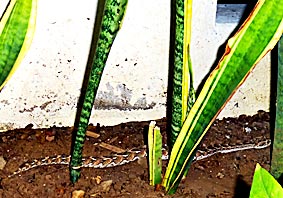 | 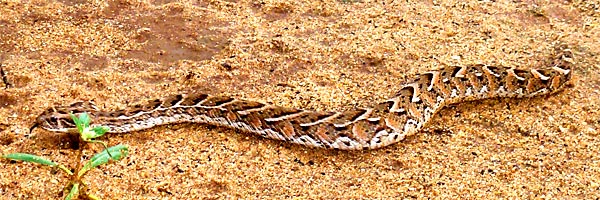 | |||||
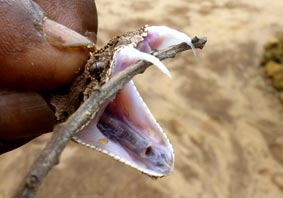 |
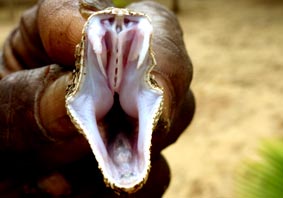 |
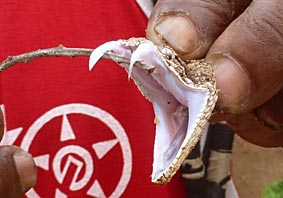 |
||||
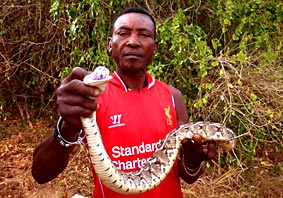 |
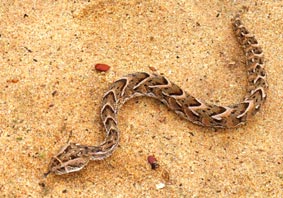 |
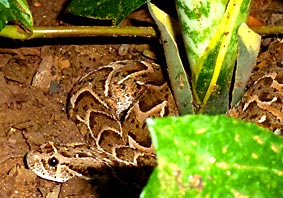 |
||||
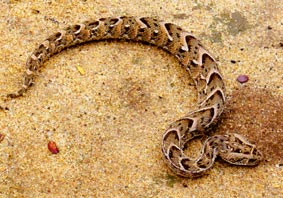 |
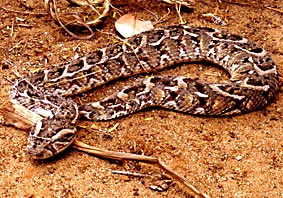 |
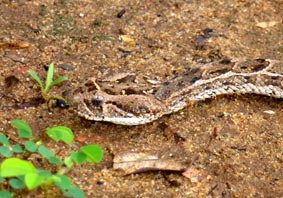 |
||||
| One evening, it was raining heavily. The house was very warm, so I went out onto the terrace for a breath of cooler air. As I looked at the little wall that serves as a demarcation to the flower bed, one about 70 centimeters long snake. It was not very bright, so I first had to take a closer look, to be able to determine what it is for a snake. As I got closer, I saw the typical thick triangular head of vipers and knew that it is a young puff adder. Puff adders are nocturnal vipers and are living in Africa. In case of danger, they swell up and give the typical hissing sound, which owes its name to the snake. Generally puff adders are not aggressive. Their diet consists mainly of small mammals, birds, snakes and amphibians. Puff adders not really chasing, but lurking on their prey. If their victims are close enough they come easily. Puff adders don’t lay eggs. Up to 80 pups can grow in the womb. Then these little poisonous snakes come with almost 25 centimeters to the world and are just as toxic as adult specimens. |
||||||
|
||||||
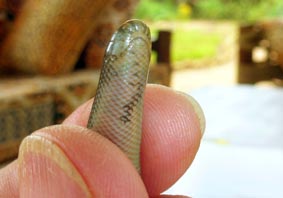 |
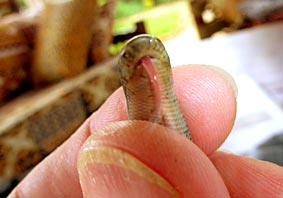 |
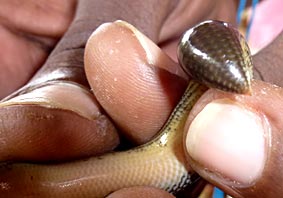 |
||||
|
This blind snake we found near the forest is 25 cm long. They can grow up to 1 Meter. The head is round and slightly flattened. The underdeveloped eyes are indeed seen but obviously have no function. At the tail end of the snake has a horny thorn. They live underground, but come to the surface when it rains. They feed on insects and their eggs and larvae. |
||||||
|
||||||
| This midsize South-East-African snake occurs in dry and wet savannas. Likewise, they are found in coastal thickets and forests to 1700 msl. In Kenya it is mainly on the coastal strip south of Malindi prior to the Tanzanian border. In Tanzania, it is however more widespread. |
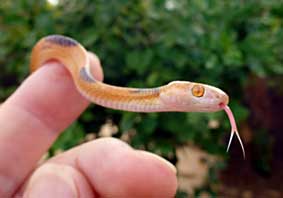 |
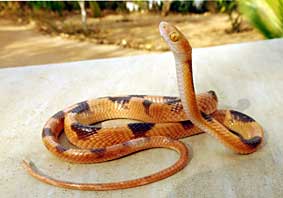 |
||||
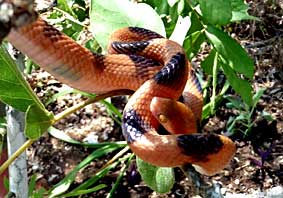 |
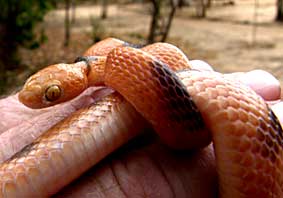 |
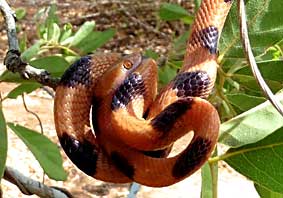 |
||||
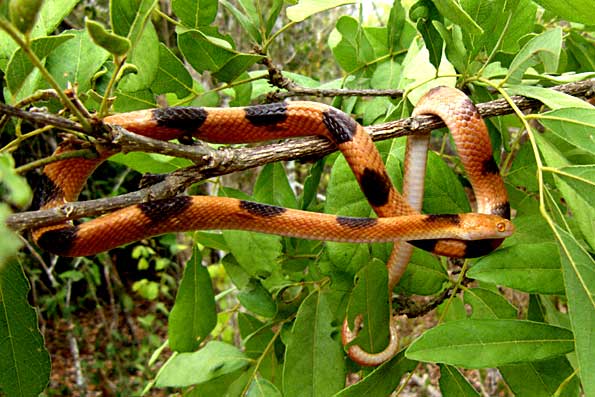 |
The tiger-snake is a night fighter and winds on the ground, climb on bushes and trees. There they searched hollows and nests for prey. During the day it hides like in cavities. They also rolled dormant for balls encounter in bushes and trees. Their diet consists of geckos, chameleons, rodents, other snakes, birds and bats. This non-aggressive reptile moves slow and cumbersome and was photographed with no problems. |
|||||
|
||||||
This dark gray nocturnal, harmless snake is not seen very often in East Africa. It has vertical pupils and a dark iris and a purple tongue. In Kenya, it occurs in the northern coastal plain, from Malindi to the Somali border. It is found in coastal thickets, flood plains, river forests, in moist and dry savanna up to 600 meters altitude. The average size is 55 cm. Their main food consists mainly of amphibians. When threatened, the Tana Herald Snake behaves similar to the White-lipped Snake (Croaphopeltis hotamboeia). It is also easily confused with the White-lipped Snake, which is however speckled white. I was very lucky to see this specimen in my garden and took some photos. |
||||||
|
|
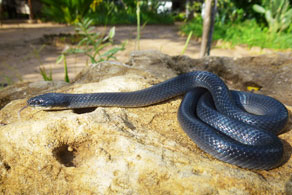 |
|||||
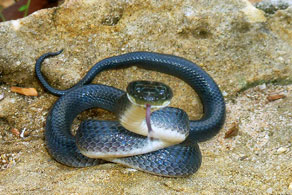 |
||||||
|
|
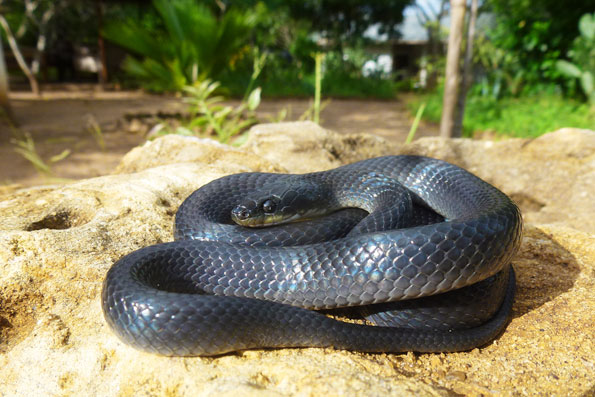 |
|||||
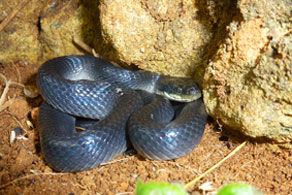 |
||||||
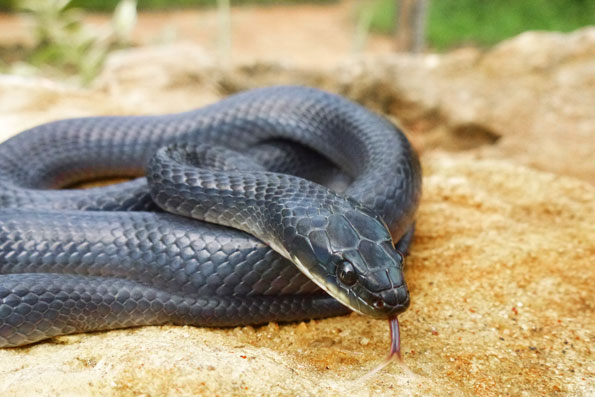 |
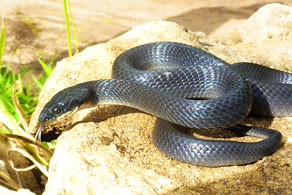 |
|||||
|
||||||
|
|
||||||
